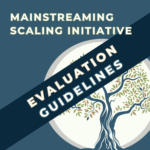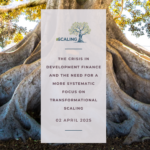
Speakers
Moderator: Larry Cooley, President Emerits of Management Systems International
Keynote speaker: Dzingai Mutumbuka, Chair of the Association for the Development of Education in Africa
Presenter: Johannes Linn, Senior Fellow at Brookings Institution
Panellists:
- Anita Sundari Akella, Director of Impact at Scale at CARE
- Matthew Will, Senior Technical Advisor for Adaptive systems at Scale at CRS
- Charlotte Coogan, Evaluation and Learning Specialist at Food Security Evidence Brokerage.
Event insights
The Society for International Development (SID) and the Scaling Community of Practice co-hosted an engaging and thought-provoking event on mainstreaming scaling practices in development funding and implementation organizations. The session brought together funder-implementers and global thought leaders to explore what it takes for funders to mainstream approaches to transformational scaling—sustainable, systemic solutions that address problems at scale – within their organizations. Here are some key lessons from the conversation:
- Shift from projects to systems: think beyond the pilot
“Project mode,” as one speaker put it, is holding us back. The old playbook—designing short-term interventions with limited scope—isn’t enough to meet global needs. Instead, funders, implementers, and governments must collaborate to build sustainable systems.
Lesson: Think of every project as the foundation for the next phase of scale. Build platforms for future growth—through systems, partnerships, and pathways that extend far beyond your organization.
Example: CRS realized that achieving impact required layering multiple projects over decades. By designing programs with a years-long scaling vision, they transitioned from isolated wins to systemic change.
- Define “scale” and be bold about it
If scaling simply means “doing more,” we will never reach transformational impact. Scaling must aim for “runaway growth”—not just replicating projects but influencing systems and policies to address problems at their full magnitude.
Lesson: Organizations must align internally on what “scale” means and should be ambitious in their definitions. Is it systemic adoption by governments? Widespread replication through partnerships? Whatever it is, define it clearly and aim big.
Example: CARE’s breakthrough came when they redefined their vision for scale. Instead of replication limited by their own footprint, they leaned into systems change—like the global adoption of their Village Savings and Loans Associations (VSLA) model by governments and NGOs alike.
- Collaboration is the cornerstone of scale
Scaling is not a solo effort. It requires co-creation, long-term partnerships, and local leadership. Governments, funders, INGOs, and communities must align their efforts—not just for one-off projects, but for sustained systems change.
Lesson: Localization isn’t a buzzword—it is a requirement for sustainable scale. Build trust, shift decision-making power, and invest in local organizations that can lead scaling efforts.
Example: Recent engagements with funding recipients emphasized the need for long-term, flexible funding to support local organizations. Without resources for capacity-building, compliance, and organizational stability, even the best ideas will struggle to grow.
- Incentivize scaling: align processes with the mission
For transformational scaling to succeed, organizations need to change from within. That means aligning internal incentives, funding mechanisms, and monitoring systems with the goal of scaling impact—not just delivering outputs.
Lesson: Redefine success. Move beyond metrics that celebrate project completion or short-term impact. Instead, measure progress toward sustainable, systemic change.
Challenge: Both CARE and CRS shared that internal resistance often comes from operational structures designed for short-term wins. Transforming those systems takes patience, persistence, and visionary leadership.
The Road Ahead: Scaling with Courage and Commitment
The SID event showcased real progress—CARE and CRS have demonstrated what is possible when organizations commit to scaling. But their journeys also revealed the gaps and challenges ahead:
- Funders must rethink their role—not just as financiers but as partners in systems change.
- Organizations must align their internal processes, incentives, and metrics with the long-term vision of scale.
- Recipients need the tools, funding, and trust to take the lead in scaling solutions in their own contexts.
As Larry Cooley put it: “we’re not where we need to be, but we’re certainly not where we were.” The momentum for scaling is growing, and the Scaling Up Community of Practice is committed to driving this agenda forward.
Join the Movement: Build Systems, Think Scale, Make Impact
The future of sustainable development lies in our ability to scale ideas that work. Whether you’re a funder, implementer, researcher, or policymaker, the message is clear: Think scale, invest in local leadership, and commit to the long game.
Want to get involved?
Join the Scaling Up Community of Practice and be part of the global effort to take solutions to scale.




